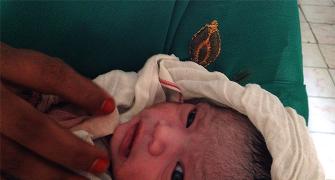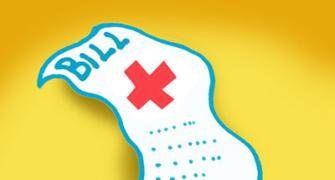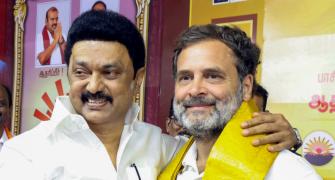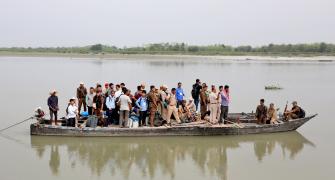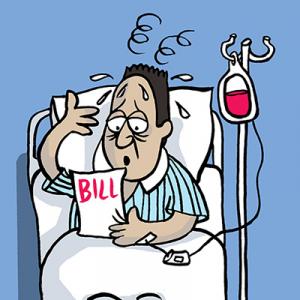Uttar Pradesh still remains far behind the Indian average on most health indicators, says Dipa Sinha.
Illustration: Dominic Xavier/Rediff.com

Uttar Pradesh continues to make front page news, three weeks after the most followed state elections have been completed.
One of the issues which did not figure much in the run-up to the campaigning, or even after, is the health and nutrition status in the state.
The initial results of the much-awaited National Family Health Survey data, based on a survey conducted in 2015-16, have recently been released.
While the fact sheets for 11 states were released last year, the all-India statistics as well as fact sheets for all the remaining states have only been brought out last month.
Presumably because of elections, the fact sheet for Uttar Pradesh was withheld and only released after the last round of polling on March 6.
The NFHS-4 presents mixed results for India as well as UP -- moderate improvements in a number of indicators such as child malnutrition and antenatal care, along with impressive performance in a few, such as institutional delivery and total fertility rate.
At the same time, new concerns related to high rates of caesarean sections and increasing prevalence of overweight/obesity among adult men and women, are also seen.
On the whole, in comparison with other countries at similar levels of economic development, including our South Asian neighbours, India continues to perform poorly on health and nutrition.
In India, UP has some of the worst indicators.
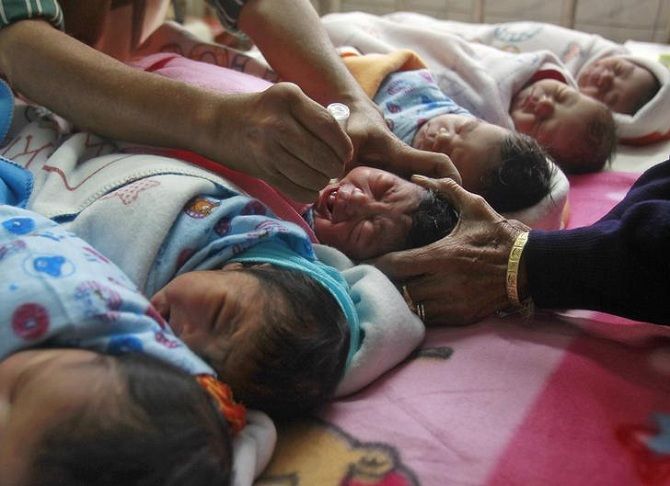
UP has the largest population in the country and the state not only influences national politics but national statistics as well.
NFHS-4 data shows that UP still remains far behind the Indian average on most of the health indicators, despite some modest improvements in the past 10 years.
The infant mortality rate in UP, at 64 per 1,000 births, is the highest in the country with the all-India average being 41. IMR in UP is even higher than the Indian average for 10 years back (57 in 2005-06, NFHS-3), indicating that at this rate the state will not be able to catch up in the foreseeable future.
Almost 50 per cent of children are not fully immunised, 46.3 per cent children under five years are stunted (low height for age) and 39 per cent children are underweight. The corresponding Indian averages are 62 per cent, 38.4 per cent and 35.7 per cent.
About 63.2 per cent children and 52.4 per cent of all women are anaemic.
The state is also behind when it comes to fertility rate. While there has been a significant fall in total fertility rate from 3.8 to 2.7, this is the Indian average for a decade earlier.
Only 32 per cent of currently married women use any modern method of family planning, with an 18 per cent unmet need for family planning in the state.
On many of these indicators, UP’s statistics are close to some of the poorest and most deprived countries in the world.

The immediate task of the state government is to assess the status of health and nutrition in the state and develop comprehensive strategies to address the situation. The availability of NFHS data at the district level could be very helpful in this process.
It must be recognised that social determinants such as poverty, women’s status and living standards are as important as access to healthcare facilities.
Only 33 per cent of women in UP have completed 10 or more years of schooling and 16.5 per cent were engaged in work where they were paid in cash.
Merely 35 per cent households use improved sanitation facilities (23 per cent in rural areas) and just 33 per cent use clean fuel for cooking.
All of these impact health and nutrition outcomes.
At the same time, in terms of health provision, huge gaps remain in the state.
The Rural Health Statistics for 2016 shows that less than five per cent of the PHCs in the state meet the Indian Public Health Standards and there is hardly any increase in the number of PHCs after 2000.
There are massive gaps in human resources in public health facilities, with 50 per cent of doctors’ positions in PHCs remaining vacant and less than one-fifth the required number of physicians being available at community health centres.
NFHS-4 data shows that there is a demand for health care facilities and people are willing to go to public facilities as well.
As a result of the Janani Suraksha Yojana and the accompanying campaigns, the institutional births in public facilities increased from a mere 6.6 per cent in 2005-06 to 44.5 per cent in 2015-16.

Overall, there is an increase in institutional births from 21 per cent to 68 per cent.
While 49 per cent of the women received financial assistance under JSY for institutional delivery (Rs 1,400), on an average they had to bear an out-of-pocket expenditure, at public health facilities, of Rs 1,956.
The state has to work on a war footing to address these gaps by increasing the allocations made for health, enhancing spending capacity and most importantly sending a strong message across that health is now a political priority.
Even the central government will have to take health in UP more seriously, if it is to meet the goals of the National Health Policy, 2017.
The UP government opened an RFP in December 2016 to outsource primary health care centres to private players.
It must be realised that it would be futile to depend on privatisation to be able to respond to this situation of poor social determinants and inadequate health provision. It is time for the state to take on the responsibility for the health of the people by improving the access and quality of services.
Dipa Sinha teaches at the School of Liberal Studies, Ambedkar University, Delhi.


